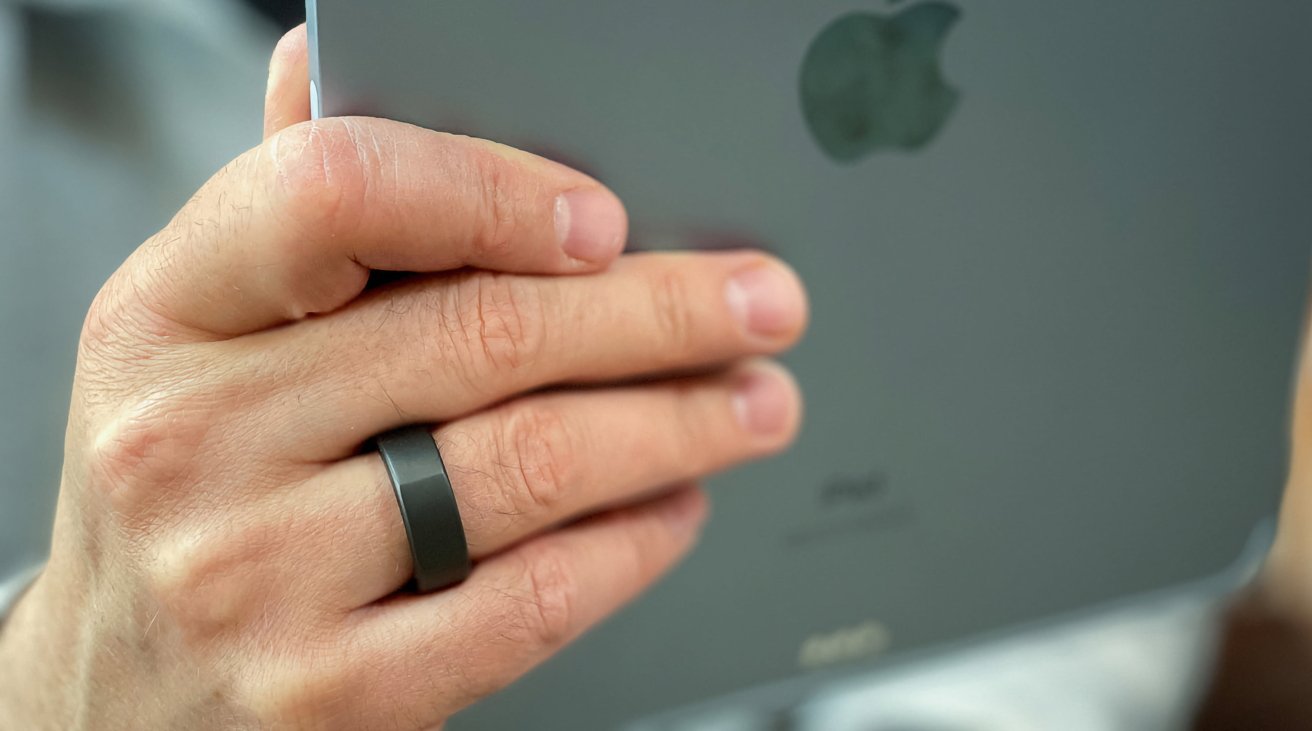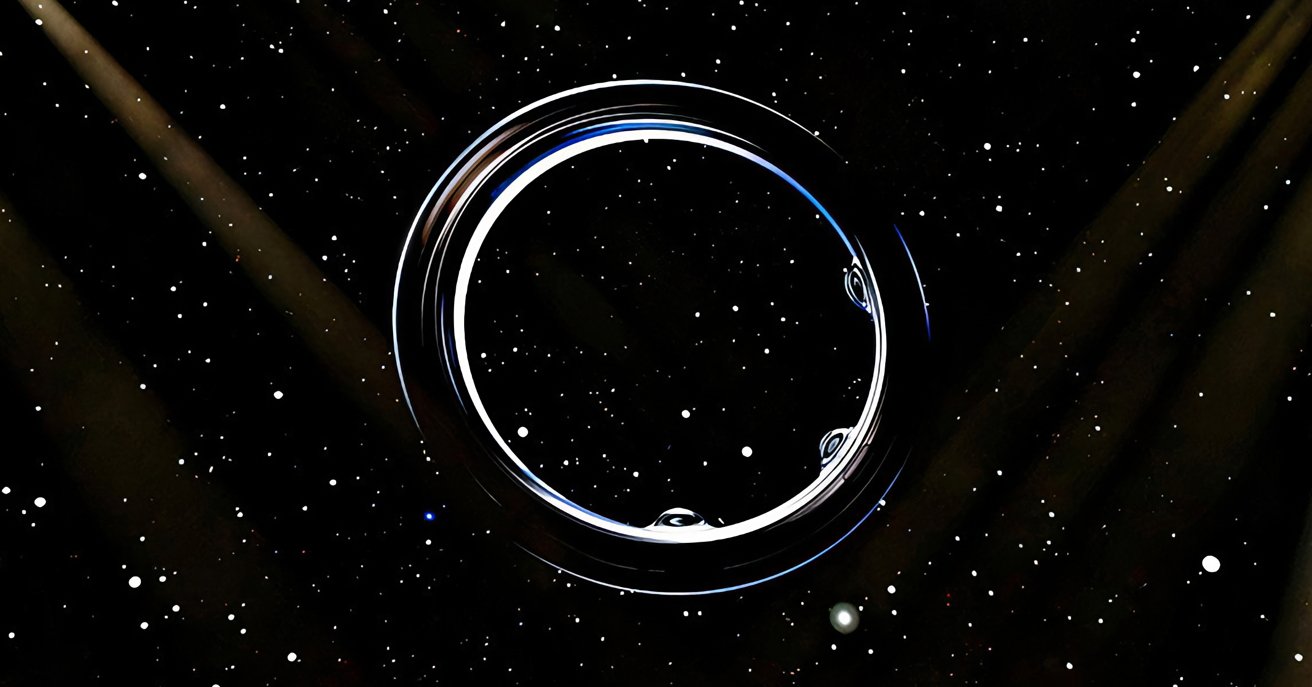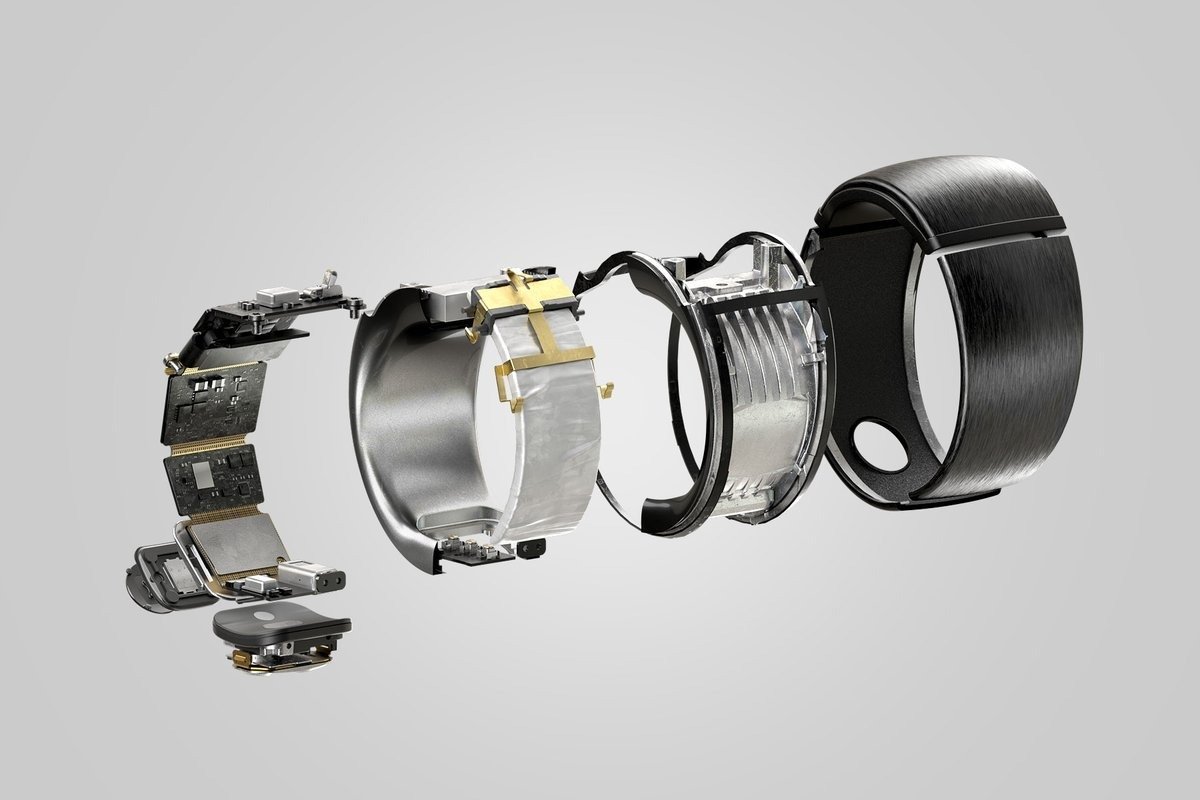Samsung has made it clear that they are shipping a smart ring in the near future. Apple has been considering the concept for almost a decade, and here’s how we know, and a glimpse of what they may have planned.
During Samsung’s Unpacked event for 2024, which saw the launch of new Galaxy S24 smartphones, the South Korean electronics giant also teased an entry into a relatively small market. Going beyond smartwatches, Samsung declared it was working on a smart ring, the Galaxy Ring, that could be released later in 2024.
Smart rings have been around for a while, with the most well-known model being the Oura Ring. The wearable, which appears like discrete jewelry, is lined with sensors in a similar manner to a smartwatch, with it tracking data points for heart rate, blood oxygen level, movement, and nightly body temperature.
With a massive tech company like Samsung wading into the smart ring market at some point in the future, the attention therefore shifts over to Apple. As the current dominant force of the smartwatch market, a smart ring seems like a progression forward for the Apple Watch maker.
Unlike other wild rumors, this is one that actually seems realistic.
Just like many other innovative companies with massive research and development budgets, Apple does spend a lot of time and effort coming up with new ideas. It also files a lot of patents every year, to protect those same concepts.
Over time, AppleInsider has reported on the various smart ring patents and applications that have come out of Cupertino. Collectively, they all hint at where Apple could be taking the smart ring concept, if it does decide to take on Samsung in the field.
Apple Ring: A fairly old idea
The patent reporting does illustrate that Apple has pondered the utility of smart rings for a considerable amount of time. One fairly dated possibility is an application that surfaced in October 2015, showing Apple has at least thought about it for close to a decade.
That filing, for “Devices and methods for a ring computing device” basically describes a miniature Apple Watch worn on a finger. While miniature in size, the device is still shown with a miniature touch-enabled display, as well as many elements that feature in the Apple Watch itself.
Indeed, Apple was keen enough on the idea of a miniature Apple Watch on a finger that it made a continuation filing that was granted in 2019 on the same idea.
The list of capabilities proposed in the 2015 filing includes heart rate monitoring, and inductive charging, Force Touch, the Taptic Engine for haptic feedback, and an accelerometer and gyroscope for gesture input. These latter two also proposed the possibility of handwriting recognition.
Back at this time, the use of voice control was also proposed, as well as communications over Wi-Fi, Bluetooth, and NFC, among other elements. There was also a lot of discussion about using the ring to control other hardware.
The filing certainly wasn’t the earliest reference to an Apple ring, with concepts surfacing in 2007 and murmurs from an Apple supplier tour in 2013 predating the patent filing. But the application does at least give concrete proof that Apple did explore the concept.
Apple Ring – Open Gestures
Long before Apple introduced the Double Tap gesture to the Apple Watch, the company was thinking of ways to interact with a smart ring without actually touching it. Sure, a touchscreen display would make control more obvious, but for a device without a screen, or a fiddly small one, gesture recognition is the way forward.
In a patent for “Skin-to-Skin Contact Detection” granted in April 2023, Apple covers multiple ways to detect contact or movement gestures between two body parts. For example, a thumb touching a finger, a thumb coming into contact with multiple fingers on the same hand, or touching other body parts.
With a gesture performed, electrodes could sense the motion or action and then perform the relevant action.
Detecting body gestures is one thing, but applying it to other hardware is another matter entirely.
In one 2020 patent application, Apple proposed that a smart ring would use the power of ultra wideband to detect a device that the user wants to interact with. In effect, a user could point their ring-wearing hand at a device, and with the U1 chip or something similar at work, the ring could tell the device that it is about to be interacted with by the user.
At that point, a user’s interactions with the ring, such as specific movements or gestures, could be used to control the intended hardware.
Slightly adjacent to rings, Apple also considered in a patent that surfaced in 2022 how a fingertip-worn device could offer gesture controls. A wag of the finger could be used to interact with a nearby display, albeit not in a form that could easily be worn all the time by users.
Apple Ring – Pressure and haptics
Continuing the theme of controlling other things, the idea has surfaced in other patents from Apple.
Granted in August 2023, the “Ring input device with pressure-sensitive input” describes a device that could not only provide controls to the user, but also notify them of events.
On receiving a wireless input from a companion device, the ring could communicate that there’s something the user should investigate. For example, a smartphone notification could translate into a haptic buzz on the finger.
For the control element, Apple’s patent mentions the use of a rotating outer band surrounding a stationary inner band that stays in contact with the user’s finger. By rolling the external ring around the finger, this could turn into switching between options, or granular options on a sliding scale like volume adjustment.
When combined with other elements, such as detecting taps or other gestures, this could give users a lot more control over what they’re interacting with.
Apple Vision Pro control
The idea of controlling something else has even greater meaning when you pair the thought with a new piece of hardware, like the Apple Vision Pro.
In November 2020, a patent application surfaced describing a “wearable electronic device configured to be worn on a finger of the user,” accompanied by a “head-mounted device comprising a display viewable by the user.” In short, a headset like the Apple Vision Pro, and a smart ring.
Rather than just being a normal ring, Apple’s filing proposes that a sheathed element could extend out towards the fingertip. This element would theoretically allow for granular inputs of a finger bend, which could be relayed to the headset.
The ring would also include a sensor and a visual marker, helping the headset detect its position and movements, again enabling a form of gesture input.
With the Apple Vision Pro shipping without any additional controllers and relying on camera-based tracking of a user’s hands and finger movements, this does leave the door open for a potential smart ring control, if Apple decides to go down that route.
Not just a finger ring
A lot of Apple’s smart ring patents involve finger rings, but some do stretch the concept quite a bit. We’ve already discussed the finger-tip-mounted device and the sheath earlier, but there’s more to think about.
A patent granted in March 2020 for an “Expandable Ring Device” proposes a two-part ring that separates and extends along the finger, with an intermediary sheathe. Expanding across two knuckles, the arrangement could again include sensors to detect motion and finger bends.
Once again, haptic feedback could be present, though spread across two areas of the finger instead of just one. Mentions of a rotatable housing, spinning buttons, and other elements also indicate there could be a lot more control options for a nearby thumb.
Indeed, Apple has covered not just rings for fingers, but has considered other wearable types that it could potentially produce.
Under the pressure sensitivity patent, it gives finger rings as an example, and says it could be applied to ring input devices worn “as part of a necklace, hoop earrings, electronic bracelet bands that are worn around the wrist, electronic toe rings, and the like.”
In a more recent patent from November 2023, Apple cares more that it has a ring shape to be worn somewhere on a part of the user. Apple says this includes “around a user’s wrist, arm, leg, ankle, neck, head, and/or other body part.”
That patent also describes the ring as being worn throughout the day and interacting with other devices in an environment. As a talisman, it could grant entry to specific areas of a building, for example, with external displays able to be used instead of relying on on-ring indicators.
Such a concept would certainly work for earrings and other type of body accessories.
Apple Ring is a possibility, but not a certainty
With so many patent filings in existence, the prospect of an Apple-created smart ring is entirely plausible. It has put the research and development in, and it has many opportunities to make the concept work with its existing product range.
Even so, it may never happen. As AppleInsider often says about patents, they indicate where Apple has thought about future features and products, but are never a guarantee that future products and services will exist using the ideas.
A quick look at the history of the smart ring market also offers warnings for Apple. The aforementioned Oura Ring is a market leader, but in a market with few credible rivals.
Among the tech giants, Samsung has obviously shown interest in bringing a smart ring to market, but it can still delay or pull out of the prospect altogether.
Meanwhile, Amazon did jump in with its own Echo Loop ring in 2019 with a promising device offering haptic feedback and button-activated microphones that worked with a tethered smartphone. However, after being sold in limited quantities, Amazon effectively gave up on the concept a year later.
Apple certainly will have observed the market for a long time and will have learned lessons from those who’ve stuck around and the failures. It will know what it can do, what it can offer the market, and whether the market is ready for an Apple smart ring.
Ultimately, it’s down to Apple whether we continue to keep it as a pocket or wrist-based companion, or if it should occupy a ring finger.


![An Apple smart ring concept from a patent application in 2015 [USPTO]](https://topnews.media/wp-content/uploads/2024/01/58214-118630-pat12015-xl.jpg)
![Smart ring gestures could allow for the ultimate game of Rock, Paper, Scissors... [USPTO]](https://topnews.media/wp-content/uploads/2024/01/58214-118631-53912-108480-001-Scissors-xl-xl.jpg)
![A rotatable outer ring could offer an extra dimension of control [USPTO]](https://topnews.media/wp-content/uploads/2024/01/58214-118632-55967-113607-001-Detail-of-Smart-Ring-xl-xl.jpg)
![An expandable smart ring [USPTO]](https://topnews.media/wp-content/uploads/2024/01/58214-118633-38774-73942-Apple-Expandable-Ring-xl-xl.jpg)
![Ring-shaped and ring-sized examples from a November 2023 patent [USPTO]](https://topnews.media/wp-content/uploads/2024/01/58214-118634-57481-117089-000-lead-Ring-devices-xl-xl.jpg)


